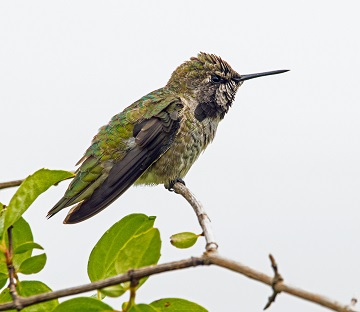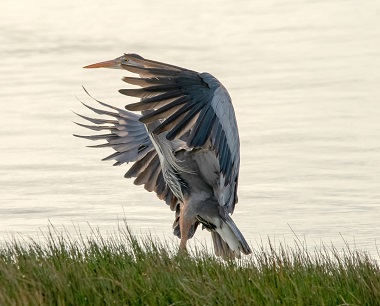
A great blue heron lands on a post on the Fraser River. Photo: Richard Topping
Stalking the wild birds near his home provides a chance to focus and be still, writes the President of Vancouver School of Theology.
I live on a river delta, where the Fraser River meets the Georgia Strait and the Pacific Ocean in Richmond.
The confluence of ocean and river is a magnet for raptors and migratory birds. They converge here in the wetlands and berry bushes, perching high up in the black cottonwoods and swooping down to fish and hunt.
My son is a marine pilot and the captain of a whale-watching boat; he photographs breaching killer and humpback whales along the coast where we live. Also among his images are airborne eagles. His pleasure at these magnificent captures shows up in stunning photos that hang on my office walls and around our home.
Inspired by my son’s images, I returned during the pandemic to my old hobby of photography. He helped me get a digital camera, and infected by his delight (and grounded with a little catechesis in digital photography), I now snap on the telephoto lens and go where the birds are almost every Saturday morning. Like a popular resort town, or perhaps even a seminary, our area has both seasonal and permanent residents. On every excursion, I meet familiar friends and surprising newcomers.

A male northern pintail duck flies above the water. Photo: Richard Topping
Wildlife photography that is more than point-and-shoot requires full attention. I am an administrator and a teacher by profession. My mind races and whirls with details all the time. I get caught up in the world inside my head, and I get twitchy when I am not multitasking.
But I find precious relief from all of that when an osprey hovers overhead. I need a shutter speed fast enough to avoid a blurry picture and an aperture allowing depth of field and light enough to avoid a noisy picture. When it works, wow!
The arresting sound of the red-eyed spotted towhee draws my attention. This bird lets you get close. The “park the car in the middle of the road and jump out with the camera” response at the sight of a migratory Bullock’s oriole surprises both me and the bird.

Anna’s hummingbird; this photo was featured in Canadian Geographic magazine in 2022. Photo: Richard Topping
I study the details to see things I cannot catch when the bird is in motion. The intricacy of its wings and their shingle-like overlay. The surprise of the bird’s prey, clutched in its talons, that I had not noticed in real time.
Sometimes I drop my camera to my side and watch with amazement as an osprey hits the water and emerges from the splash with its catch in its claws.
In physics, the observer effect is the disturbance of a system by the act of observation. Photographers experience this phenomenon. I think of myself as a bird watcher.
But I look at my photos, and what I see are birds watching me. What is watched has agency. Some birds, like dogs, put their heads at an angle and watch you watching them.
My son often reminds me that the birds saw and heard us coming before we knew they were there. Storming through the woods in loud conversation often generates silence in the woods and encourages bird flight. Photographers disturb what’s going on with their presence. Success at photography – a good image capture – often means lingering long enough to become part of the ecology.
I like to start out early in the morning before the seaside noise begins, before the barges ply the river and the seals disappear, before the barking dogs rove the beaches and the pintails and green-winged teals take off. All of this activity is important; I am not naive about what it takes to sustain a community.
Yet the quiet matters too. It makes us porous to the beauty of creation. It makes us less threatening. It brings creatures and other things, like sanity, back.

A bald eagle looks down at the photographer from his perch. Photo: Richard Topping
Friends, sometimes surprised at a good photo of mine on social media, have commented, “You must have a good camera.” That hurts. I bought a T-shirt that says, “Cameras do not take pictures, photographers do!” I do have a good camera, but that’s no guarantee of success.
What my friends do not know is how many times my photography fails. More photos fail than not. Once, I took my camera in for repair because I’d worn out the delete button. There’s a lot that can go wrong.
The light is not always right (it rains a lot here in Vancouver). When I wait at the foot of a black cottonwood tree where an eagle is perched, the bird may not take flight – or may depart after I walk away. Ospreys may stay just out of photographic reach. I have been stung by bugs more than once, and I happened upon a coyote who growled at me. A red-winged blackbird winged into my face when I got too close to its nest.
Some photographers use a Bluetooth speaker in the woods to summon birds with fake calls. Simulacrum! A sign of impatience, I think: an unwillingness to wait for the world to come to you, forcing creation to a command performance. Waiting in an accelerated world like ours is considered a problem to be solved. The German sociologist Hartmut Rosa claims that modernity is a process of speeding things up. That modern life in the West is all about dynamic equilibrium; we accelerate just to stay in the same place, like going up the down escalator.

Great blue herons scan for fish or other small creatures. Photo: Richard Topping
Waiting on the chance for a good shot takes time. And it’s worth it. Sometimes I go out for an hour and it turns into half a day of waiting and watching. And then – surprise and delight.
I don’t always end up with a picture of what I thought I would get. There is an element of sheer luck in the hunt for the beautiful, and I am reminded of St. Augustine’s Easter sermon from 16 centuries ago:
Question the beauty of the earth, question the beauty of the sea, question the beauty of the air, amply spread around everywhere, question the beauty of the sky, question the serried ranks of the stars, question the sun making the day glorious with its bright beams, question the moon tempering the darkness of the following night with its shining rays, question the animals that move in the waters, that amble about on dry land, that fly in the air; their souls hidden, their bodies evident; the visible bodies needing to be controlled, the invisible souls controlling them; question all these things.
They all answer you, “Here we are, look; we’re beautiful.”
Their beauty is their confession. Who made these beautiful changeable things, if not one who is beautiful and unchangeable? (St. Augustine, Sermons, 241, Easter, 411 CE)
Sometimes I wonder what I am really looking for, carrying a camera through a thicket. I don’t do photography for a living. I do it for life.
This was first published in Faith & Leadership and is re-posted by permission.
